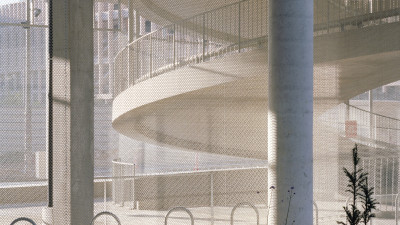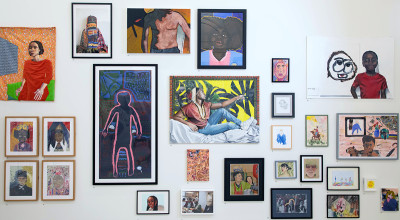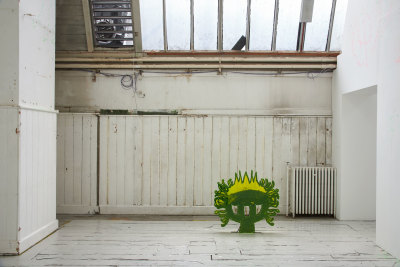Francis Kéré’s straws travel to Sierra Leone
Francis Kéré’s straws travel to Sierra Leone
By Rebecca Milling
Published 4 July 2014
Rebecca Milling describes the story of how straws from our ‘Sensing Spaces’ exhibition travelled to Swawou Layout Foundation Primary School for Girls, Sierra Leone.
-
The story of my workshops with the pupils of the Swawou Layout Foundation Primary School for Girls in Kenema, Sierra Leone, began in London, at the Royal Academy of Arts in March 2014, when I was visiting the innovative Sensing Spaces exhibition with my four year-old daughter.
We spent a considerable amount of time making things out of straws in the Diébédo Francis Kéré exhibit. These were not ordinary drinking straws, but colourful ones, at least a metre-long, and they were there to play with and construct what ever we wanted. We then attached our creations to Francis Kéré’s large architectural structure made out of plastic honeycomb sheets.
I became intrigued by the number of people, of all ages and types, who were also choosing to spend time making something of their own to add to the overall effect of Kéré’s design. Slowly, it dawned on me that long coloured straws were the perfect lightweight, cheap material to take with me to do workshops with schoolgirls in Sierra Leone. Hopefully, the girls would have the same instinctive urge to make something with them as the hundreds of people passing through the Sensing Spaces exhibition.
-

Attaching the straws to the structure
Photo credit: Peter Dibdin
-
I returned home to discover that one metre long coloured straws are not as easy to find as I had thought, especially in the large quantities I would need. So I got in touch with the RA, hoping someone could point me in the right direction. I was so pleased when, having got straight through to Ann Gilmore in the Learning Department, she said that they might be able to donate some to me if they had any left over after the exhibition finished.
Thanks to the diligence and co-operation of the Curator, Kate Goodwin and Exhibition Manager, Nicole Ruegsegger, I was lucky enough to have a very large suitcase full of brightly coloured straws accompanying me to Sierra Leone.
The first staff meeting in Sierra Leone took place sitting on benches in the shade of a tree outside Swawou School. I explained my straws construction project to the teachers, putting it in the context of the girls being given the opportunity to build something themselves as they watched their new school being built further up the road.
Despite the generous welcome which we had received when we arrived, I was a little unsure of how the teachers would respond to a creative project - and how much time they would be able to spare in the school day for me to do it. I needn’t have worried: they were very open to the idea and immediately got to work arranging the timetable to suit the workshops and I was given 1 hour 45 minutes with each class starting at 9.30am on Monday.
-

Students enjoy getting creative with the materials
Photo credit: Peter Dibdin
-
There are four classes at Swawou School for Girls which provides free education to disadvantaged girls from the Swawou Community of Kenema, eastern Sierra Leone. They are provided with a uniform, all stationery supplies and lunch in a safe, nurturing environment where they are educated without the use of corporal punishment. The girls spend four years at the school and range in age from 7 to 15, as they don’t necessarily always start aged 7. The current school, where I was teaching, is made from sticks and woven palm leaves with a tarpaulin roof.
You cannot imagine the heat in the school and the noise coming from the neighbouring market which runs along behind, until you have experienced being there. Nothing can be left in the school overnight because it is not secure and the rain stops classes because it comes in through the roof. I am describing this so that you have an idea of the commitment of the teachers who work there and also because their lives are going to radically change in September when they move into their new school made from clay bricks.
The new school will have a staff room, kitchen, covered courtyard, large peaceful surrounding area and secure doors, as well as providing more space for more pupils. The school has been designed by architects, Orkid Studios, who are managing the project, and exchanging skills working with local people to erect the building.
-

Celebrating successful construction
Photo credit: Peter Dibdin
-
My first workshop was with the younger pupils. I have to admit to feeling slight trepidation as I arrived with my very large suitcase full of straws and some empty water bottles. I was partly anxious because I had been told that the girls were not necessarily very good at thinking creatively because of the very structured method they are taught with. Apparently, a letter writing exchange with a school in the UK had failed because they were simply not used to thinking of something of their own to write.
Despite this, I jumped in feet first and explained that we were going to try and build from one side of the classroom to the other using the straws and the empty water bottles for foundations. Everyone laughed at the mention of foundations because I think that there has been much talk of their new school’s foundations, so I suggested that we could finish our building first.
I showed them how to join two straws together and, in no time, we were building. Everyone was concentrating and working together, until we had a few square rooms next to each other stretching almost from one side of the room to the other.
This happened so quickly and efficiently with no ideas from me of how to build, that I was taken by surprise and we still had half the lesson left. Some girls started plaiting the straws together and soon we had made very long plaits - which someone piped up we could use as the roof. Before I knew what was happening, it was lunch time and the girls had gone off and immediately come back to sit inside their straw building with their lunch.
-

Eating lunch in the straw building.
Photo credit: Peter Dibdin
-
The third workshop was with the next class up. I again split the class into three groups and told them we were going to make arches for us to walk through. This turned out to be a hugely successful workshop, and the girls starting off with complete diligence and enthusiasm for the task in hand. The air was buzzing with quiet excitement as the arches were erected, each one very different from the other, until we were able to walk right though them all.
After a while, we decided to take them outside and managed to squeeze them through the door and then join them together, so that we could follow each other through them. We then played their favourite game, Follow the Leader, using the arches as a central focus. This game is when one person stands in the middle and she has to guess who is starting the dance move for everyone to copy. By this time, we had got many onlookers from the local market and the children from another school on their lunch break intrigued by what was going on, “I want to go to this school” said one. There was a crazy race from the many children to grab as many of the straws from the arches as possible when I told them that they could break it up. The arches lasted seconds!
-

Follow the leader.
Photo credit: Peter Dibdin
-
The fourth workshop was with the oldest girls who will be leaving next year having completed their four years at primary school. There has been talk of building a playground in the grounds of the new school building, so I had brought pictures from home of some simple playground equipment. I didn’t see one playground in Kenema but the girls did seem to know what I was talking about when they saw my pictures and were very excited at the prospect of making one out of straws.
However, this turned out to be the least creative workshop because the girls were looking at the pictures and trying to copy what they saw. We did enjoy making things like a seesaw and a wobbly bridge, although it was in a much more methodical way where bunches of straws were bound together to be stronger, more like a piece of wood, and a seesaw plank was woven together with straws using a basket weaving method. The outcome was that the straws were used in an attempt to resemble the properties of wood rather than using the properties of the straws to create something new.
-

Students play in the structures they created
© Peter Dibdin
-
Altogether, these workshops were very successful, each one very different from the last. I couldn’t have asked for a more positive, creative and hands-on response from the girls and the teachers. The straws did inspire the urge to make something, just as they had for people in the Sensing Spaces exhibition. But in Sierra Leone, they were greeted with so much more excitement, awe and enthusiasm than they ever could have been in the UK.
I feel that these workshops highlighted the power of creativity in society and I know that what happened in them won’t be easily forgotten but continued throughout the community as word is passed on from the girls and onlookers alike. Perhaps I am now an Art Missionary, which is a daunting statement, but I am now positive that you don’t have to be a doctor or an NGO worker to help and inspire people in one of the world’s poorest countries.
Sensing Spaces: Architecture Reimagined was at the RA from 25 January - 6 April 2014.
Find out more about the Swawou School Foundation and the work of Orkidstudio
Find out more about Rebecca Milling and Peter Dibdin.









